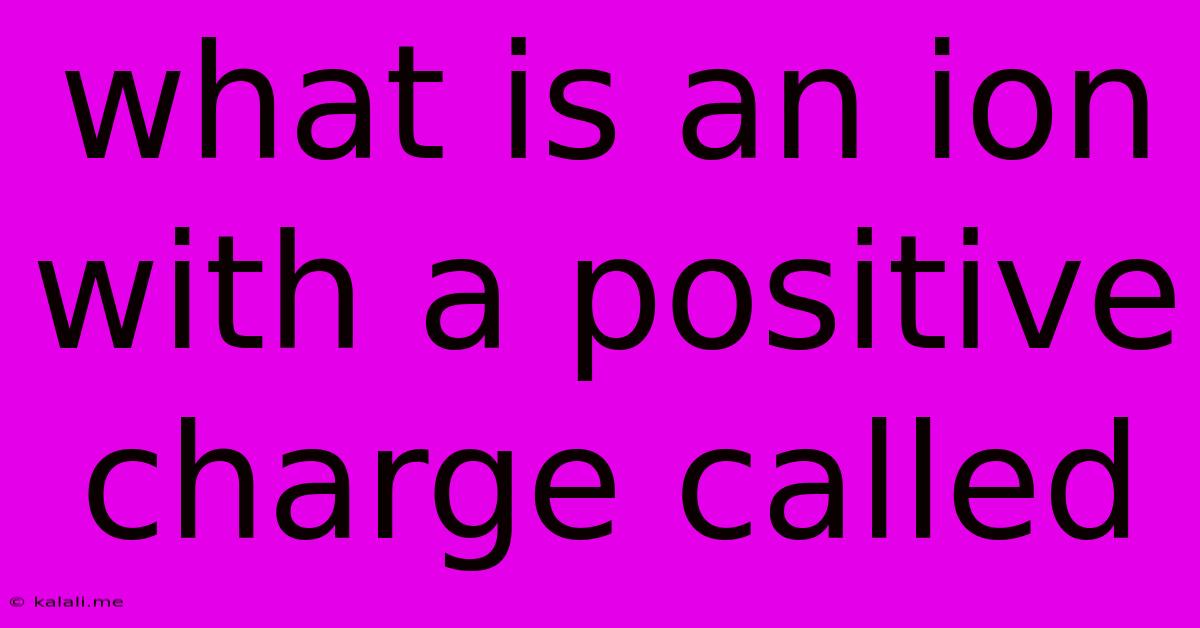What Is An Ion With A Positive Charge Called
Kalali
Jun 15, 2025 · 3 min read

Table of Contents
What is an Ion with a Positive Charge Called? A Simple Explanation
Have you ever wondered about the fundamental building blocks of matter and how they interact? Understanding ions, and specifically those with a positive charge, is key to grasping the basics of chemistry and physics. This article will explore what an ion with a positive charge is called, why it carries that charge, and its significance in various scientific fields.
An ion with a positive charge is called a cation. This simple definition forms the bedrock of understanding many chemical processes and properties. Let's delve deeper into the "why" behind this charge and the broader implications of cations.
Understanding Ions: The Basics
Before we focus on cations, let's clarify what an ion is. An ion is an atom or molecule that has an unequal number of protons and electrons. Protons carry a positive charge, while electrons carry a negative charge. A neutral atom has an equal number of protons and electrons, resulting in a net charge of zero.
However, atoms can gain or lose electrons through various processes like chemical reactions or ionization. When an atom loses one or more electrons, it becomes positively charged because it now has more protons than electrons. This positively charged atom (or molecule) is what we call a cation.
How are Cations Formed?
The formation of cations often involves the transfer of electrons. This typically occurs in chemical reactions between elements with different electronegativities. Electronegativity refers to an atom's ability to attract electrons towards itself. Elements with lower electronegativity tend to lose electrons more readily, forming cations.
For example, consider the reaction between sodium (Na) and chlorine (Cl). Sodium has a low electronegativity and readily loses one electron to achieve a stable electron configuration. This results in the formation of a sodium cation, denoted as Na⁺. Chlorine, on the other hand, gains this electron, becoming a negatively charged chloride ion (Cl⁻). This transfer of electrons forms an ionic bond, holding the two ions together in a stable compound – sodium chloride (NaCl), or table salt.
Examples of Common Cations
Many common elements form cations. Here are a few examples:
- Sodium ion (Na⁺): Found in table salt and essential for various bodily functions.
- Calcium ion (Ca²⁺): Crucial for strong bones and teeth, muscle contraction, and nerve transmission.
- Potassium ion (K⁺): Important for maintaining fluid balance and nerve impulse transmission.
- Magnesium ion (Mg²⁺): Plays a role in many enzymatic reactions and muscle function.
- Hydrogen ion (H⁺): A key component in determining acidity (pH) in solutions. Often simplified as a proton.
- Iron ion (Fe²⁺ and Fe³⁺): Exists in two common cation forms, both vital for oxygen transport in the blood (hemoglobin).
The Significance of Cations
Cations play a crucial role in numerous biological and chemical processes. Their positive charge allows them to interact with negatively charged ions and molecules, influencing chemical reactions, electrical conductivity, and the structure of materials. From the functioning of nerves and muscles to the stability of minerals and the formation of ionic compounds, cations are essential components of the world around us.
Conclusion
In summary, an ion with a positive charge is definitively known as a cation. Understanding cation formation, common examples, and their roles is vital for grasping the fundamentals of chemistry and their diverse applications across various scientific disciplines. This knowledge provides a foundation for exploring more complex concepts in the fascinating world of ions and their interactions.
Latest Posts
Latest Posts
-
Which Of These Has Radial Symmetry
Jun 15, 2025
-
Which Of These Statements Is Not True About Project Scheduling
Jun 15, 2025
-
How To Count The Highlighted Cells In Excel
Jun 15, 2025
-
What Is The Oxidation Number Of Fe
Jun 15, 2025
-
Which State Of Matter Has The Highest Kinetic Energy
Jun 15, 2025
Related Post
Thank you for visiting our website which covers about What Is An Ion With A Positive Charge Called . We hope the information provided has been useful to you. Feel free to contact us if you have any questions or need further assistance. See you next time and don't miss to bookmark.